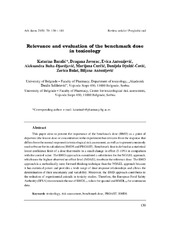Relevance and evaluation of the benchmark dose in toxicology
Značaj i procena benchmark doze u toksikologiji
| dc.creator | Baralić, Katarina | |
| dc.creator | Javorac, Dragana | |
| dc.creator | Antonijević, Evica | |
| dc.creator | Buha-Đorđević, Aleksandra | |
| dc.creator | Ćurčić, Marijana | |
| dc.creator | Đukić-Ćosić, Danijela | |
| dc.creator | Bulat, Zorica | |
| dc.creator | Antonijević, Biljana | |
| dc.date.accessioned | 2020-08-19T09:16:37Z | |
| dc.date.available | 2020-08-19T09:16:37Z | |
| dc.date.issued | 2020 | |
| dc.identifier.issn | 0004-1963 | |
| dc.identifier.uri | https://farfar.pharmacy.bg.ac.rs/handle/123456789/3644 | |
| dc.description.abstract | This paper aims to present the importance of the benchmark dose (BMD) as a point of departure (the lowest dose or concentration in the experiment that deviates from the response that differs from the normal response) in toxicological risk assessment, as well as to present commonly used software for its calculation (BMDS and PROAST). Benchmark dose is defined as a statistical lower confidence limit of a dose that results in a small change in effect (5-10%) in comparison with the control value. The BMD approach is considered a substitution for the NOAEL approach, which uses the highest observed no-effect level (NOAEL) to obtain the reference dose. The BMD approach is a methodically more forward-thinking technique than the NOAEL approach because it has statistical power and provides a wide range of dose-response relationships and allows the determination of their uncertainty and variability. Moreover, the BMD approach contributes to the reduction of experimental animals in toxicity studies. Therefore, the European Food Safety Authority (EFSA) recommends the use of BMDL10values for quantal and BMDL05for continuous data. | en |
| dc.description.abstract | Cilj ovog rada je da predstavi značaj granične benchmark doze (engl. benchmark dose, BMD) kao polaznog doznog nivoa (najniže doze ili koncentracije u eksperimentu koja odstupa od normalnog odgovora) u toksikološkoj proceni rizika, kao i da prikaže najčešće korišćene softvere za njeno izračunavanje (BMDS i PROAST). Benchmark doza predstavlja statističku donju granicu pouzdanosti doze koja dovodi do malog povećanja efekta (5-10%) u odnosu na kontrolnu vrednost. Benchmark pristup predstavlja alternativu NOAEL (engl. no observed adverse effects level, NOAEL) pristupu, u kome se u svrhu dobijanja referentnih vrednosti koristi najviša doza koja ne izaziva štetan efekat. Benchmark pristup naučno je napredniji metod od tradicionalnog NOAEL pristupa, jer je statistički utemeljen, daje širok opseg podataka o odnosu doza-odgovor i omogućava kvantifikaciju njihove nesigurnosti i varijabilnosti. Takođe, BMD pristup doprinosi smanjenju broja eksperimentalnih životinja u toksikološkim studijama. Samim tim, Evropska agencija za bezbednost hrane (EFSA) preporučuje primenu doza BMDL10 za kvantalne i BMDL05 za kontinuirane podatke. | sr |
| dc.language.iso | en | sr |
| dc.publisher | Beograd : Savez farmaceutskih udruženja Srbije | sr |
| dc.rights | openAccess | sr |
| dc.rights.uri | https://creativecommons.org/licenses/by-sa/4.0/ | |
| dc.source | Arhiv za farmaciju | sr |
| dc.subject | toxicology | sr |
| dc.subject | risk assessment | sr |
| dc.subject | benchmark dose | sr |
| dc.subject | PROAST | sr |
| dc.subject | BMDS | sr |
| dc.subject | toksikologija | sr |
| dc.subject | procena rizika | sr |
| dc.subject | benchmark doza | sr |
| dc.title | Relevance and evaluation of the benchmark dose in toxicology | en |
| dc.title | Značaj i procena benchmark doze u toksikologiji | sr |
| dc.type | article | sr |
| dc.rights.license | BY-SA | sr |
| dcterms.abstract | Баралић, Катарина; Јаворац, Драгана; Aнтонијевић, Евица; Буха-Ђорђевић, Aлександра; Ћурчић, Маријана; Булат, Зорица; Aнтонијевић, Биљана; Ђукић-Ћосић, Данијела; Значај и процена бенцхмарк дозе у токсикологији; Значај и процена бенцхмарк дозе у токсикологији; | |
| dc.citation.volume | 70 | |
| dc.citation.issue | 3 | |
| dc.citation.spage | 130 | |
| dc.citation.epage | 141 | |
| dc.citation.rank | M52 | |
| dc.identifier.doi | 10.5937/arhfarm2003130B | |
| dc.identifier.scopus | 2-s2.0-85088903383 | |
| dc.identifier.fulltext | https://farfar.pharmacy.bg.ac.rs/bitstream/id/7982/Relevance_and_evaluation_pub_2020.pdf | |
| dc.type.version | publishedVersion | sr |

